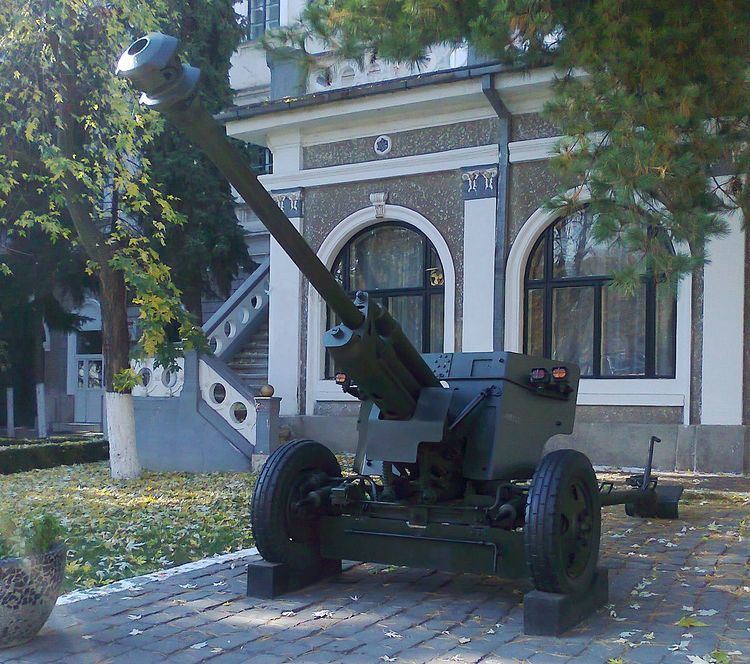In service 1943—45? | Designed 1942—43 | |
 | ||
The 75 mm Reșița Model 1943 was an anti-tank gun produced by Romania during World War II. It combined features from the Soviet ZiS-3 fieldanti-tank gun, the German PaK 40 and the Romanian 75 mm Vickers/Reșița Model 1936 anti-aircraft gun. It saw service against both the Soviets during the Jassy-Kishniev Offensive and against the Germans during the Budapest Offensive and subsequent operations to clear Austria and Czechoslovakia.
Contents
Development
Development began in 1942 of a dual-purpose field and anti-tank gun that could be built in Romania to replace the collection of obsolescent field guns currently used and upgrade their anti-tank defenses of the army. To speed development Colonel Valerian Nestorescu suggested combining the best features from the 75 millimetres (3.0 in) guns already in service in Romania, Germany or captured from the Soviets. Colonel Nestorescu was selected to produce a prototype to be built at the Uzinele şi Domeniile Reşiţa in Reşiţa. Three prototypes were built combining various features and trialled against the ZiS-3, a Reşiţa-built copy of the ZiS-3, the Pak 40 and the Schneider-Putilov Model 1902/36 field gun in September 1943 and the third prototype had the greatest armor penetration. It was adopted as the Tunul antitanc DT-UDR 26, cal. 75 mm, md. 1943, commonly shortened to 75 mm Reşiţa Model 1943.
Description
It combined the muzzle brake, recoil and firing mechanisms and split-trail carriage of the ZiS-3, the barrel, rifling and cartridge chamber of the Vickers/Reşiţa Model 1936 anti-aircraft gun and the projectile chamber of the Pak 40. It had a gun shield that consisted of two 6 millimetres (0.24 in) plates separated by a 20 millimetres (0.79 in) gap. It had only 680 parts, almost as few as the 610 of the ZiS-3, but far fewer than the 1200 of the Pak 40. It had a higher muzzle velocity and thus greater penetrative power than the Pak 40. It therefore combined virtues of both the ZiS-3 and Pak 40. 1100 were ordered on 10 December 1943 from Uzinele și Domeniile Reșița, Astra in Braşov and Concordia in Ploieşti.
The 75 mm Reșița Model 1943 fired a 6.6 kg (15 lb) armor-piercing shell at 1,030 metres per second (3,400 ft/s). It was credited with penetration of a plate over 100 millimetres (3.9 in) thick angled at 30° from the vertical at 500 metres (550 yd). However, this high muzzle velocity came at the cost of a very short barrel life, only 500 rounds, compared to the 6000 of a Pak 40. Its ammunition combined features of shells used by the Pak 40 and the Vickers/Reșița Model 1936 anti-aircraft gun, although this raises the issue of exactly how the Reșița Model 1943 achieved such velocities. The Pak 40 had a muzzle velocity of 990 m/s (3,200 ft/s) when firing the light-weight, tungsten-cored Pzgr 40 shell, but the only data for the Reșița give a shell weight of 6.6 kg (15 lb), which is roughly equivalent to the Pak 40's full-sized 6.8 kg (15 lb) Pzgr 39 shell that was fired at a mere 792 metres per second (2,600 ft/s). Unfortunately detailed specifications for the Reșița's ammunition haven't been discovered so that question will have to remain unanswered.
Operational use
The first twenty-four were issued to the 1st Armored Division in the spring of 1944 and later two independent anti-tank regiments with thirty-six guns apiece formed from the artillery regiments of the disbanded Frontier Division. Most of the cavalry and infantry divisions began to receive some guns during the summer of 1944. An estimated 342 were produced by the end of 1944. However, the gun displayed in Oradea has serial number 394, thus the production run was likely larger. Despite the losses suffered during the Soviet Jassy-Kishniev Offensive of August 1944 most divisions at the front in February 1945 had between six and twelve 75 mm Reșița Model 1943 on hand. After the war, the gun was relegated to secondary roles, such as training, because it had a western caliber. The 75 mm Reșița Model 1943 was used until 1998, when it was phased out.
The gun was also used on the later prototypes of the Mareșal tank destroyer.
One is on display today at the Romanian National Military Museum in Bucharest. Another is displayed on the sidewalk in front of the Military Museum in Oradea. Two more guns are emplaced in Libertatii Square in Timisoara. A fifth gun is preserved in the Dej Military Museum.
